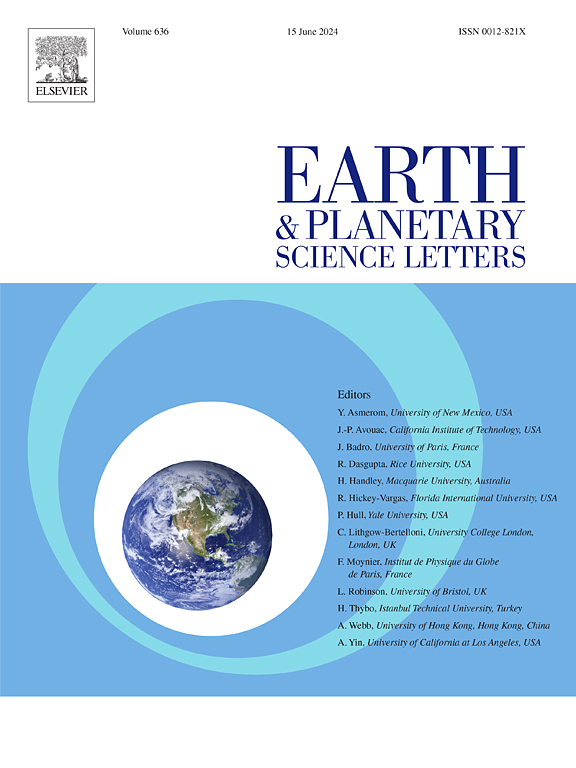Fluid-mediated transition from dynamic rupturing to aseismic slip at the base of the seismogenic continental crust
IF 4.8
1区 地球科学
Q1 GEOCHEMISTRY & GEOPHYSICS
引用次数: 0
Abstract
Chemo-mechanical fluid-rock interactions are critical in controlling the frictional-viscous transition in the continental crust and the competition between seismic and aseismic deformation in fault zones. In this study, we provide quantitative constraints on the timing and magnitude of weakening, and associated changes in slip rates, due to fluid-rock interactions at the base of the seismogenic continental crust. Integrating field, microstructural analyses, and micromechanical modelling we constrain the microstructural and mechanical evolution of phyllosilicate-rich, carbonate-bearing brittle-ductile faults/shear zones developed in the Rieserferner granitoid pluton (Eastern Alps). Here, transient overpressure of (H2O + CO2)-rich fluids triggered dynamic rupturing in the strong host rock (>100 MPa), and promoted the development of weak phyllonites through long-term fluid-mediated feldspar-to-mica reactions. These phyllosilicate-rich fault rocks accommodated frictional-viscous aseismic creep at very low differential stresses (<10 MPa) and near-lithostatic fluid pressure conditions. Microscale vein networks overprinting the phyllonite indicate cyclical embrittlement related to increased creep rates (up to 10−7 s−1) that occurred over a timeframe of days to months and potentially related to slow earthquakes (slip rates of 10−8 m/s). These findings offer new constraints on the development and seismogenic potential of phyllosilicate-rich fault zones and on the effect of fluid chemistry on fault zone rheology. Fluid-mediated fault weakening can occur in rather short time (months-to-years) comparable to the interseismic period, progressively promoting long-term, viscous aseismic creep on a previously strong fault zone developed by dynamic rupturing. The combined effect of strain localization, the low permeability of the phyllonitic cores, as well as of fluid chemistry evolution and CO2-enrichment, may lead to the development of brittle-frictional instabilities during transient accelerated-creep events. Therefore, the fluid-mediated microstructural evolution of phyllosilicate-rich fault rocks controls their seismogenic behaviour, potentially leading to accelerated creep, slow earthquakes and slow slip on otherwise aseismically creeping faults.
流体介导的大陆地壳底部从动态破裂到无震滑动的过渡
化学机械流体-岩石相互作用是控制大陆地壳摩擦-粘性转变以及断层带地震变形和非地震变形竞争的关键。在这项研究中,我们提供了关于成震大陆地壳底部流体-岩石相互作用导致的弱化时间和幅度以及相关滑动速率变化的定量约束。综合实地分析、微观结构分析和微观力学建模,我们对富含植物硅酸盐、含碳酸盐的脆性-韧性断层/剪切带的微观结构和力学演化进行了约束,这些断层/剪切带发育于雷塞尔费纳花岗岩岩体(东阿尔卑斯山)。在这里,富含(H2O + CO2)流体的瞬时超压引发了坚固主岩(100 兆帕)的动态破裂,并通过长期流体介导的长石-云母反应促进了软弱辉长岩的发育。这些富含长石硅酸盐的断层岩在极低的差应力(10 兆帕)和近基性流体压力条件下可承受摩擦粘性地震蠕变。覆盖在辉绿岩上的微尺度矿脉网络表明,周期性脆化与蠕变速率(高达 10-7 s-1)的增加有关,蠕变速率的增加发生在几天到几个月的时间内,可能与慢地震(滑动速率为 10-8 m/s)有关。这些发现为富含植物硅酸盐断层带的发展和致震潜力以及流体化学对断层带流变学的影响提供了新的约束条件。流体介导的断层弱化可在与地震间歇期相当的短时间内(数月至数年)发生,逐渐促进先前由动态破裂形成的坚固断层带的长期粘性地震蠕变。应变局部化、辉绿岩岩芯的低渗透性以及流体化学演化和二氧化碳富集的共同作用,可能会导致瞬态加速蠕变事件期间脆性摩擦不稳定性的发展。因此,富含辉绿硅酸盐的断层岩由流体介导的微结构演化控制着它们的致震行为,有可能导致加速蠕变、慢震和在无震蠕变断层上的慢滑。
本文章由计算机程序翻译,如有差异,请以英文原文为准。
求助全文
约1分钟内获得全文
求助全文
来源期刊

Earth and Planetary Science Letters
地学-地球化学与地球物理
CiteScore
10.30
自引率
5.70%
发文量
475
审稿时长
2.8 months
期刊介绍:
Earth and Planetary Science Letters (EPSL) is a leading journal for researchers across the entire Earth and planetary sciences community. It publishes concise, exciting, high-impact articles ("Letters") of broad interest. Its focus is on physical and chemical processes, the evolution and general properties of the Earth and planets - from their deep interiors to their atmospheres. EPSL also includes a Frontiers section, featuring invited high-profile synthesis articles by leading experts on timely topics to bring cutting-edge research to the wider community.
 求助内容:
求助内容: 应助结果提醒方式:
应助结果提醒方式:


